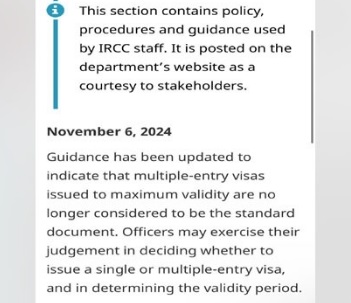Canada ends 10-year visitor visa and announces changes as The Government of Canada has introduced updates to visitor visa regulations. These changes aim to streamline the application process and enhance the travel experience for visitors. The authorities will no longer offer the 10-year visitor visa.
Introduction
The Immigration Department has recently announced a new policy regarding multiple-entry visas, now available for a duration of 10 years but granted selectively. Immigration officers on-site will exercise their discretion to make these decisions, ensuring that they tailor the process to meet specific criteria..
Additionally, the Department of Immigration and Citizenship is focusing on enhancing the visitor visa system. Most visas are now issued as single-entry and typically last between 6 months to one year. This approach aims to streamline the visa process while maintaining security and oversight.

Under the new policy, immigration officers will evaluate applicants based on their purpose for visiting Canada. If the visit is for specific events such as weddings, conferences, or training sessions, the applicant will qualify for a single-entry visa.
This approach may introduce some adjustments for frequent travelers, as they might need to apply for visas more often. However, the government anticipates that these measures will effectively help manage immigration levels while addressing concerns about the growing number of temporary residents.
The visa policy update is part of Canada’s broader approach to balancing immigration and public concerns.
Previous Canada’s Visitor Visa Policy
In the previous system, the IRCC offered two types of tourist visas: multiple entry and single entry. All applicants automatically received consideration for a multiple-entry visa, which allowed them to enter Canada multiple times during the visa’s validity period. This visa could last up to 10 years or until one month before the passport expired, whichever came first.
Single-entry visas, on the other hand, allowed travellers to enter Canada only once. These visas typically cater to specific situations, such as when foreign nationals eligible for fee exemptions make official visits, when individuals participate in unique events in Canada, or when they meet certain country-specific guidelines. After leaving Canada, holders of single-entry visas would generally need to apply for a new visa to return.
What Has Changed?
The new guidance introduces a more flexible approach to visa applications. Instead of standardizing multiple-entry visas with maximum validity, officers will now assess each applicant on an individual basis. This allows for the possibility of issuing either a single-entry or multiple-entry visa tailored to the applicant’s specific needs. Additionally, the duration of these visas can vary based on the unique circumstances of each traveler, providing a more personalized and relevant visa experience.

Cost of Visa
The application fee for a Canadian visitor visa is set at CAD 100 per person, applying equally to both single-entry and multiple-entry visas. This means that applicants will not encounter any cost differences when choosing between a single-entry or multiple-entry option, allowing for a straightforward decision-making process.
Wider Immigration Measures
The recent update to Canada’s visa policy is a significant step within a comprehensive strategy to harmonize immigration levels with public concerns about infrastructure. In addition to this update, Canada has introduced various other initiatives to address these important issues, demonstrating a commitment to both welcoming newcomers and ensuring the sustainability of public resources which includes:
Lowering permanent resident targets: The government has made adjustments to its immigration levels plan, setting a new target of 395,000 new permanent residents for 2025, followed by 380,000 in 2026 and 365,000 in 2027. This approach aims to ensure that integration and support systems can effectively accommodate new arrivals.
Cap on international students: Canada has introduced a cap on student permits. This strategic move is anticipated to gradually reduce the number of international students by approximately 300,000 over the next three years, allowing for a more balanced and sustainable educational environment.
Restrictions on temporary foreign workers: The Temporary Foreign Worker Program has been adjusted to enhance workforce quality, resulting in a 10% to 20% reduction in the proportion of low-wage foreign workers that businesses can employ. This change aims to encourage employers to seek a more skilled labor force.
Visa requirements reinstated for Mexican citizens: To address the increase in asylum claims and unauthorized border crossings, Canada implemented a visa requirement for Mexican nationals on February 29, 2024. This measure aims to enhance border management and ensure a more organized process for travelers.







